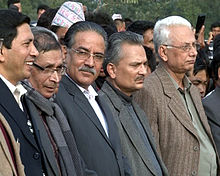Nepal is a Democrat country. Many political parties are established in Nepal. Out of them, the Maoist is the most criminal political party of Nepal, Because they killed 17,000 people of Nepal to get the chair of the president of Nepal. They create a civil war ( maobadi dwanda) between 1996-2006. It was the ten years-long war between the Communist Party of Nepal ( Maoist) and the government of Nepal. It is also is known as Mawovadi Dwandakaal. The day 13 Feb 1996 was the black day of Nepalese because the day Maoist decides to killed 17,000 people in Nepal. The Maoist said their demand is People's republic but that wasn't their actual demand.
In 1996 The kingdom of Nepal was lead by King 'Birendra Birbikram shah Dev'. He was a great king of Nepal. He always takes public as the first position. He thought about the people of Nepal.
The maoist Revolution was lead by Prachanda ( Puspa kamal Dahal ),laldhwaj ( baburam ) , kiran ( mohan Baidya ) ,Pasang ( Nandakishwor pun ).
As the government side, the war was lead by King Birendra Birabikram Shah Dev ( 1972-2001) and King Gayandra Birabikram Shah Dev ( 2001 - 2008).
What does Government do During War
The government, banned all anti-monarchy statements, imprisoned journalists and closed down the newspapers that were suspected of taking sides with the rebels. Talks were held between the Nepalese government and the rebel groups. The government refused to give in to the rebels’ demands of having elections to form a constitutional assembly as they felt this would lead to the elimination of the monarchy. The Maoists, on the other hand, refused to acknowledge the establishment of a constitutional monarchy. The Maoists controlled the rural areas while the government dominated the towns and the cities during the war as most of the government organizations were based in the cities.
As the government was unable to return peace in the country, on February 1, 2005, King Gyanendra decided to take total control of the country with the aim of stopping the war In May 2005, seven of the political parties established an alliance named the Seven Party Alliance. In November of the same year, the Maoist rebels and the Seven Party Alliance issued a resolution pointing out that an autocratic monarchy was the main impediment to democracy and peace. The Maoist rebels agreed to uphold peace, and it was agreed upon that elections would be carried out to form a constitutional assembly.












No comments:
Post a Comment